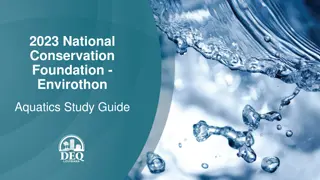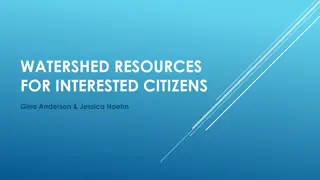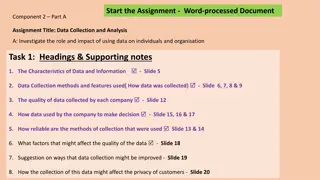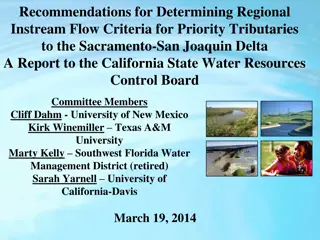Hydrologic Modeling Methods in HEC-HMS: A Comprehensive Overview
Explore the transformative methods within HEC-HMS hydrologic modeling, including unit hydrograph derivation, excess precipitation transformation, hydrograph illustration, surface transform methods, and concepts like the kinematic wave and 2D diffusion wave. Learn about the unit hydrograph, kinematic
0 views • 41 slides
Analyzing Hydrologic Time-Series for Flood Frequency Analysis
This content delves into the methods and assumptions involved in studying hydrologic time-series data for flood frequency analysis. It covers topics such as different types of assumptions, including independence and persistence, and highlights how streamflow data can be analyzed to find annual maxim
7 views • 97 slides
Understanding Routing Methods in Hydrologic Engineering Center (HEC-ResSim)
Explore the differences between hydrologic and hydraulic routing, learn about open channel flow processes, and delve into channel routing within HEC-ResSim. Discover various reach routing methods, parameter estimation techniques, and calibration approaches. Dive into the Muskingum method and its app
6 views • 29 slides
Managing Water Resources Data with HEC-DSSVue
Learn about managing gridded data in HEC-DSSVue, including how grids represent spatial data, storing data in DSS, naming conventions, tools for manipulation, and more. Explore the importance of grids in hydrologic modeling and the application of spatial data in HEC-HMS and HEC-RAS.
4 views • 42 slides
Stochastic Storm Transposition in HEC-HMS: Modern Techniques and Applications
Explore the innovative methods and practical applications of Stochastic Storm Transposition (SST) in the context of HEC-HMS. Delve into the history, fundamentals, simulation procedures, and benefits of using SST for watershed-averaged precipitation frequency analysis. Learn about the non-parametric
3 views • 41 slides
2023 National Conservation Foundation - Envirothon
Explore the intricate dynamics of aquatic ecosystems and wetlands conservation through this comprehensive study guide. Discover the importance of watersheds, the hydrologic cycle, aquatic food webs, energy flow at trophic levels, and common macroinvertebrates in Louisiana. Learn about different wetl
3 views • 27 slides
GIS Data Management in Hydrologic Engineering Center (HEC) Software
Efficiently manage GIS data in HEC software by organizing background shapefiles, saving files in relevant directories, and utilizing relative pathnames. Understand the contents of basin files, GIS directories, and the step-by-step process involved in the delineation of elements within a project.
9 views • 5 slides
Understanding Extreme Value Theory in Civil Engineering
Introduction to Extreme Value Theory (EVT) in civil engineering focusing on the analysis of extremes such as shear strength, slope stability, and load factors. The theory, exemplified by Emil Julius Gumbel, questions the likelihood of individual observations falling outside expected distributions. E
10 views • 49 slides
Revolutionizing with NLP Based Data Pipeline Tool
The integration of NLP into data pipelines represents a paradigm shift in data engineering, offering companies a powerful tool to reinvent their data workflows and unlock the full potential of their data. By automating data processing tasks, handling diverse data sources, and fostering a data-driven
9 views • 2 slides
Understanding Reservoir Inflows and Computing Methods
Explore the methods for computing reservoir inflows, including mass balance formulas, known and unknown variables, and techniques to handle negative values. Learn about linking to HMS for hydrologic engineering, estimating local inflows, and utilizing smoothing techniques for accurate results.
0 views • 24 slides
Ask On Data for Efficient Data Wrangling in Data Engineering
In today's data-driven world, organizations rely on robust data engineering pipelines to collect, process, and analyze vast amounts of data efficiently. At the heart of these pipelines lies data wrangling, a critical process that involves cleaning, transforming, and preparing raw data for analysis.
2 views • 2 slides
Data Wrangling like Ask On Data Provides Accurate and Reliable Business Intelligence
In current data world, businesses thrive on their ability to harness and interpret vast amounts of data. This data, however, often comes in raw, unstructured forms, riddled with inconsistencies and errors. To transform this chaotic data into meaningful insights, organizations need robust data wrangl
0 views • 2 slides
Hydrologic Modeling with Gridded Precipitation Data
Learn about utilizing gridded precipitation data for hydrologic modeling with HEC-HMS. Explore the advantages of spatially distributed precipitation sources such as RADAR and gauge comparisons, and understand the various national and regional products available. Discover utilities for converting and
3 views • 14 slides
Parameter Expression Calculator for Efficient Parameter Estimation from GIS Data
Parameter Expression Calculator within HEC-HMS offers a convenient tool to estimate loss, transform, and baseflow parameters using GIS data. It includes various options such as Deficit and Constant Loss, Green and Ampt Transform, Mod Clark Transform, Clark Transform, S-Graph, and Linear Reservoir. U
2 views • 5 slides
Historic Precipitation Hydrologic Modeling with HEC-HMS Slides by Greg Karlovits, Emily Moe, Daniel Black
Delve into the world of hydrologic modeling with HEC-HMS through a detailed presentation by experts Greg Karlovits, Emily Moe, and Daniel Black. Explore meteorologic models, atmospheric boundary conditions, basin modeling, and simulation runs in this informative slide series.
0 views • 12 slides
Understanding Mixed Populations in Flood Frequency Analysis
In this presentation by Gregory S. Karlovits, P.E., PH, CFM, a statistical hydrologist from the US Army Corps of Engineers, the focus is on modelling mixed populations in flood frequency analysis. The key topics include revisiting the IID assumption, identifying mixed populations, and building model
0 views • 38 slides
Understanding Gage Weights and Precipitation Methods in Hydrologic Modeling
Exploring the concept of gage weights and precipitation methods in hydrologic modeling using the HEC-HMS software. Dive into the pros and cons of flexible gage weighting, calibration processes, and best practices for estimating time and depth weights. Discover how to set up a gage weights model, inc
0 views • 11 slides
Understanding Data Governance and Data Analytics in Information Management
Data Governance and Data Analytics play crucial roles in transforming data into knowledge and insights for generating positive impacts on various operational systems. They help bring together disparate datasets to glean valuable insights and wisdom to drive informed decision-making. Managing data ma
0 views • 8 slides
Watershed Resources for Interested Citizens
Explore a variety of resources related to watersheds, wetlands, and water monitoring, including tools provided by the U.S. Fish and Wildlife Services National Wetland Inventory. Learn about different types of wetlands, access the Indiana Watershed Group Finder for locating hydrologic unit codes, and
3 views • 18 slides
Baikal Selenga Network (BaSeNet) - Hydrologic Research Program in PEEX
Baikal Selenga Network (BaSeNet) is a subprogram under PEEX focusing on studying waterborne matter transport in the Lake Baikal and Selenga River Drainage Basin. The program aims to quantify hydro-climatic impacts on large scales, utilizing a monitoring and modeling platform. Research objectives inc
0 views • 5 slides
Engineering Hydrology Course Overview and Great Salt Lake Evaporation Analysis
Engineering Hydrology course led by David Tarboton covers principles of hydrology, water balance concepts, and hydrologic modeling. The analysis of Great Salt Lake evaporation explores factors such as inflow, area, and precipitation to determine the average annual evaporation rate.
1 views • 18 slides
Over-the-Loop Streamflow Forecasting Project Summary
Joint project by USBR, USACE, and NCAR focusing on improving streamflow forecasting using automated over-the-loop approaches. Key challenges include model calibration, data assimilation, and real-time forcings. Objectives involve building an automated system for short- to long-term flow predictions
0 views • 41 slides
Understanding Data Collection and Analysis for Businesses
Explore the impact and role of data utilization in organizations through the investigation of data collection methods, data quality, decision-making processes, reliability of collection methods, factors affecting data quality, and privacy considerations. Two scenarios are presented: data collection
1 views • 24 slides
Waikato Regional Council Stormwater Guidelines Workshop Overview
The Waikato Regional Council organized an external stakeholder workshop to discuss their new stormwater guidelines, aiming to provide consistent hydrologic design practices in the region. The workshop highlighted the importance of a council-specific guideline, changes from TP 108, allowance for alte
0 views • 20 slides
Understanding the Hydrologic Cycle and Water Distribution
The hydrologic cycle, water distribution in the hydrosphere, water usage in the United States in 2005, condensation processes forming fog, cloud types, precipitation processes including ice-crystal and coalescence processes, and types of precipitation like sleet, freezing rain, hail, and graupel are
1 views • 30 slides
Advancements in Hydrologic Modeling for Enhanced Predictions
Explore the future of hydrologic modeling with a focus on distributed models, data assimilation, ensemble forecasts, and verification. Discover the potential benefits of continued research in physically based models for more accurate forecasts in various conditions. Uncover challenges facing hydrolo
0 views • 23 slides
Hydrogeology and Water Resource Management Problems
The content contains four challenging problems related to hydrogeology, evaporation, watershed hydrology, and flood control reservoir operations. It covers topics such as water table rise, evaporation rate calculation, unit hydrograph analysis, detention basin filling, and reservoir inflow routing.
0 views • 4 slides
Understanding the Hydrologic Cycle and Water in the Atmosphere
Exploring the intricate processes of evaporation, condensation, and cloud formation in the atmosphere, the hydrologic cycle's closed system, and the impact of global warming on Earth's water resources. Dive into the essential concepts of water absorption, redistribution of energy, humidity, and the
0 views • 18 slides
Recommendations for Establishing Instream Flow Criteria in Priority Tributaries
This report explores the significance of preserving instream flows in priority tributaries to the Sacramento-San Joaquin Delta and provides recommendations for determining regional instream flow criteria. Key points include the importance of flow regimes in maintaining biological integrity and the d
0 views • 11 slides
Enhancing Flow Opportunities in Scott Valley Groundwater Study
The Scott Valley Groundwater Study identifies flow enhancement opportunities to improve water management and increase stream flows. Initiatives include developing an integrated hydrologic model, exploring water management strategies, and implementing groundwater recharge projects since 2008. The stu
0 views • 6 slides
Understanding the Hydrological Cycle and Flood Hazards
This session with Dr. Patrick Asamoah Sakyi delves into the hydrologic cycle, causes of flooding, and ways to mitigate flood hazards. Topics covered include the hydrologic cycle, stream systems, flood consequences, factors affecting flood severity, and strategies for reducing flood risks. Recommende
0 views • 37 slides
Exploring Ecosystem Dynamics: Environmental Systems Study
In this Environmental Systems study, students delve into identifying native plants and animals using a dichotomous key, assessing their roles within local ecosystems, and comparing them to other biomes. They also analyze abiotic cycles such as rock, hydrologic, carbon, and nitrogen cycles, and evalu
0 views • 40 slides
Understanding Abiotic Cycles in Ecosystems: Hydrologic, Carbon, Nitrogen, and More
Abiotic cycles play a crucial role in regulating ecosystems. The hydrologic cycle involves processes like evaporation, condensation, precipitation, and transpiration. The carbon cycle relies on photosynthesis, respiration, and human activities like deforestation and burning fossil fuels. The nitroge
0 views • 20 slides
River Restoration Strategies in Oregon: ES407 Senior Seminar Working Group
Explore the efforts of the ES407 Senior Seminar Working Group from Western Oregon University in Monmouth as they delve into river restoration strategies, watershed assessment, salmonid habitat restoration, fluvial hydrology, and more. Discover the historical framework shaping modern interventions an
0 views • 7 slides
Hydrologic Data Brief for the Edwards Aquifer - October 16, 2013
Hydrological data report for the Edwards Aquifer on October 16, 2013, covering current water levels, spring flows, long-term changes, well readings, and spring discharges. The report includes trends over the last 10 days, deviations from historical averages, and water level updates for various wells
0 views • 11 slides
Evaluating Watershed Delineation Discrepancies in West Virginia
This case study explores differences between NRCS Watershed Boundary Dataset and ArcGIS auto delineation in the Upper Guyandotte Watershed in West Virginia. The project aims to quantify discrepancies, analyze landscape characteristics, examine mining impacts, and assess the variations' effects on hy
0 views • 18 slides
Implementation of the Community Hydrologic Prediction System
The Community Hydrologic Prediction System (CHPS) is a revolutionary initiative replacing the outdated NWS River Forecast System. It aims to improve hydrologic modeling infrastructure by incorporating modern forecasting concepts and models, enhancing data sharing, and fostering collaboration within
0 views • 15 slides
Understanding Biogeochemical Cycles and Their Impact on Earth's Ecosystems
Biogeochemical cycles involve the cycling of essential nutrients like water, carbon, oxygen, nitrogen, phosphorus, and sulfur through abiotic components like water, air, soil, and rock to biotic components like plants, animals, fungi, and bacteria. Humans play a significant role in these cycles, imp
0 views • 24 slides
Hydrologic Systems Analysis for Water Quality Assessment
Principals Thomas Burke and Operations Impacts in the Hydrologic Systems exhibit a comprehensive analysis of scenarios and comparison between Preferred Alternative (PA) and No Action Alternative (NAA). The assessment covers river stage reductions, channel siltation, and the impact on water quality i
0 views • 21 slides
Setting Up NWS-RFC Inflows in CWMS Forecast for Raystown Dam Project
Joan Klipsch, a Sr. Hydraulic Engineer at the Hydrologic Engineering Center, details the process of using NWS-RFC inflows in a CWMS forecast for the USACE Raystown Dam project on the Juniata River. The article provides insights on data requirements, setting up ResSim alternatives, RAS alternative co
0 views • 19 slides







































